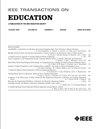Fostering Engineering Troubleshooting Proficiency: A Real-World Scenario-Based Electrical Training Hardware Using Embedded System
IF 2
2区 工程技术
Q2 EDUCATION, SCIENTIFIC DISCIPLINES
引用次数: 0
Abstract
Contribution: This article proposes the systematic integration of embedded systems into training hardware to bridge the gap in structured troubleshooting education. Traditional methods often rely on manual explanations, virtual simulations, or on-the-job training, which lack structured learning experiences. The proof-of-work module, developed based on the proposed framework, effectively simulates challenging scenarios, providing real-life troubleshooting experiences that significantly increase motivation for further learning. Background: Troubleshooting competence is typically acquired through experiential engagement and unforeseen challenges, rarely structured as a deliberate educational endeavor. Simulating real problematic conditions also poses challenges due to their complexity or potential dangers. Intended Outcome: A framework that facilitates the representation of real-life troubleshooting situations using hardware prototypes with multiple scenarios. A proven implementation, a ship’s electrical earth fault troubleshooting training hardware, exemplifies the utilization of embedded systems using the proposed framework. Application Design: Experiential Learning is commonly used to develop troubleshooting proficiency. Providing deliberate multiple scenarios through training hardware will give much more experience than unforeseen challenges in job training. Findings: The findings demonstrated statistically significant benefits of the new hardware with the embedded system in increasing user interest for further learning and product presentation, with a 95% confidence interval and significant differences adjusted p-values = 0.049. It provides evidence of embedded systems’ effectiveness and suggests their potential applications in engineering education, particularly in the electrical engineering field.培养工程故障排除能力:使用嵌入式系统的基于现实场景的电气培训硬件
贡献:本文提出将嵌入式系统系统集成到训练硬件中,以弥合结构化故障排除教育中的差距。传统的方法通常依赖于人工解释、虚拟模拟或在职培训,缺乏结构化的学习经验。基于该框架开发的工作量证明模块有效地模拟了具有挑战性的场景,提供了现实生活中的故障排除经验,大大增加了进一步学习的动力。背景:故障排除能力通常是通过经验参与和不可预见的挑战获得的,很少是通过刻意的教育努力获得的。由于其复杂性或潜在的危险,模拟真实的问题条件也带来了挑战。预期结果:一个框架,它使用具有多个场景的硬件原型来促进实际故障排除情况的表示。一艘船舶的电气接地故障故障排除训练硬件的实例验证了使用所提出框架的嵌入式系统的应用。应用程序设计:体验式学习通常用于培养故障排除能力。通过培训硬件提供深思熟虑的多种场景,将比工作培训中不可预见的挑战提供更多的经验。研究结果:研究结果显示,新硬件与嵌入式系统在增加用户对进一步学习和产品展示的兴趣方面具有统计学意义上的显著优势,95%置信区间和显著差异调整后的p值= 0.049。它提供了嵌入式系统有效性的证据,并提出了它们在工程教育,特别是电气工程领域的潜在应用。
本文章由计算机程序翻译,如有差异,请以英文原文为准。
求助全文
约1分钟内获得全文
求助全文
来源期刊

IEEE Transactions on Education
工程技术-工程:电子与电气
CiteScore
5.80
自引率
7.70%
发文量
90
审稿时长
1 months
期刊介绍:
The IEEE Transactions on Education (ToE) publishes significant and original scholarly contributions to education in electrical and electronics engineering, computer engineering, computer science, and other fields within the scope of interest of IEEE. Contributions must address discovery, integration, and/or application of knowledge in education in these fields. Articles must support contributions and assertions with compelling evidence and provide explicit, transparent descriptions of the processes through which the evidence is collected, analyzed, and interpreted. While characteristics of compelling evidence cannot be described to address every conceivable situation, generally assessment of the work being reported must go beyond student self-report and attitudinal data.
 求助内容:
求助内容: 应助结果提醒方式:
应助结果提醒方式:


